AudioCodes 445HD operation manual
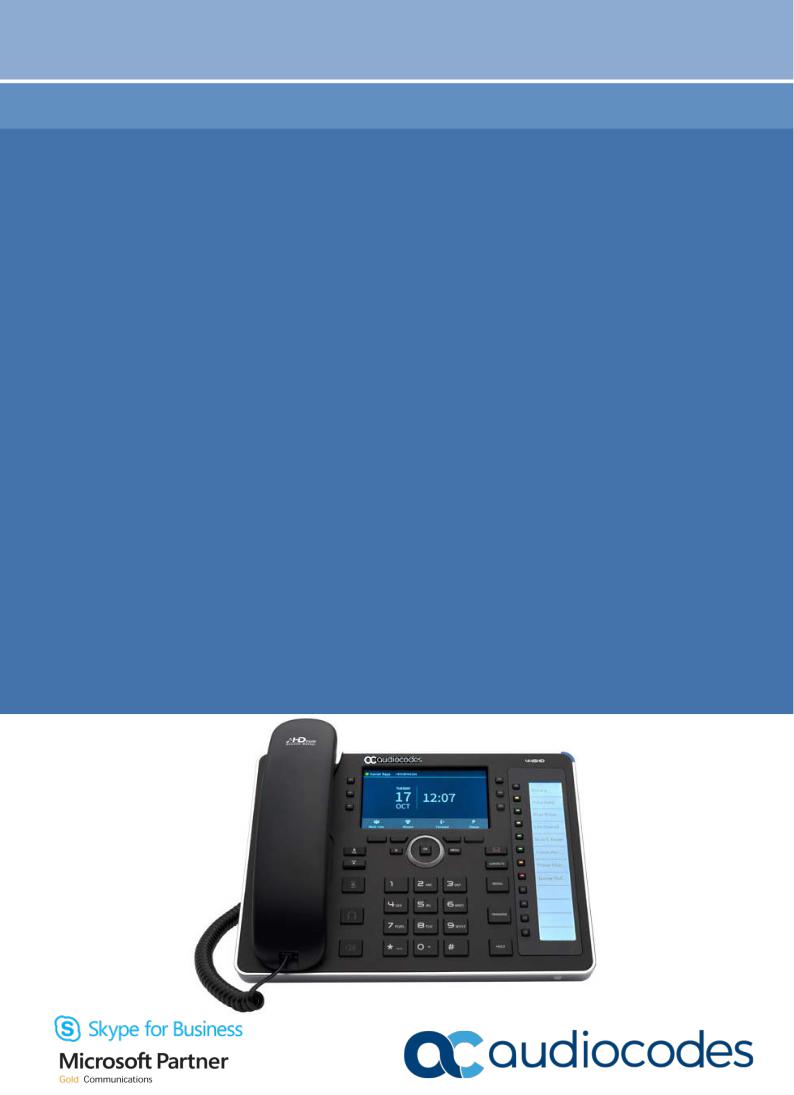
User's Manual
AudioCodes High Definition IP Phones Series
445HD IP Phone for Microsoft® Skype™ for Business
Version 3.1.1

User's Manual Contents
Table of Contents
1 Introducing the 445HD IP Phone.............................................................................. |
11 |
|||
|
1.1 |
About AudioCodes' Series of High Definition IP Phones ................................................. |
11 |
|
|
1.2 |
Cutting Edge Voice Quality & HD VoIP ........................................................................... |
11 |
|
2 Setting up the Phone................................................................................................. |
13 |
|||
|
2.1 |
Unpacking........................................................................................................................ |
13 |
|
|
2.2 |
Device Description........................................................................................................... |
13 |
|
|
|
2.2.1 |
Front View .......................................................................................................................... |
13 |
|
|
2.2.2 |
Rear View .......................................................................................................................... |
15 |
|
2.3 |
Cabling............................................................................................................................. |
16 |
|
|
2.4 |
Mounting the Phone......................................................................................................... |
17 |
|
|
|
2.4.1 |
Desktop Mounting .............................................................................................................. |
17 |
|
|
|
2.4.1.1 Routing the Handset Cable ................................................................................ |
17 |
|
|
2.4.2 |
Wall Mounting .................................................................................................................... |
17 |
3 |
Getting Started........................................................................................................... |
19 |
||
|
3.1 |
Getting Acquainted with the Phone Screen ..................................................................... |
19 |
|
|
3.2 |
Softkeys ........................................................................................................................... |
20 |
|
|
3.3 |
Navigating the Phone Menu ............................................................................................ |
21 |
|
|
3.4 |
Switching between Letters | Numbers ............................................................................. |
22 |
|
|
3.5 |
Switching to Symbols....................................................................................................... |
23 |
|
4 |
Signing In |
................................................................................................................... |
25 |
|
|
4.1 |
Signing in with PIN Code ................................................................................................. |
25 |
|
|
4.2 |
Signing .......................................................................in with User Name and Password |
26 |
|
|
4.3 |
Signing ...............................................................in with the Web Sign-in (Cloud) Option |
27 |
|
|
4.4 |
Signing ............................................................................in using the Web Login Option |
28 |
|
|
4.5 |
Signing ..........................................................in as a Common Area Phone (CAP) User |
29 |
|
|
4.6 |
Signing ......................................................................................................................Out |
32 |
|
|
|
4.6.1 ....................................Signing out if the 'Sign out' Softkey is Removed from the Screen |
32 |
|
|
4.7 |
Hot Desking ..................................................................................................................... |
35 |
|
|
4.8 |
Displayed ........................................................................................................Messages |
36 |
|
5 Unlocking .......................................................................................a Locked Phone |
37 |
|||
|
5.1 |
Manually ...............................................................................................Locking a Phone |
38 |
|
|
5.2 |
Dialing .......................................................Emergency Numbers if the Phone is Locked |
39 |
|
6 |
Customizing .............................................................................................the Phone |
41 |
||
|
6.1 |
Changing ..................................................................................................the Language |
41 |
|
|
6.2 |
Selecting ........................................................................................................Ring Tone |
41 |
|
|
6.3 |
Displaying ...........................................................................................Contacts Pictures |
42 |
|
|
6.4 |
Enabling .......................................................................................................Call Waiting |
43 |
|
|
6.5 |
Handling ...........................................................................Simultaneous Incoming Calls |
43 |
|
|
|
6.5.1 .................................................................................................Configuring Busy on Busy |
44 |
|
|
6.6 |
Configuring ............................................................................................Call Forwarding |
45 |
|
|
6.7 |
Making .........................................................................Sure the NTP Server is Enabled |
47 |
|
Version 3.1.1 |
3 |
445HD IP Phone |

|
|
|
445HD IP Phone |
6.8 |
Configuring Screen Brightness ........................................................................................ |
49 |
|
6.9 |
Selecting an Answering Device ....................................................................................... |
50 |
|
6.10 |
Configuring Location........................................................................................................ |
51 |
|
6.11 |
Uploading Logs to MS Server for Support ....................................................................... |
52 |
|
6.12 |
Configuring an Outbound Proxy ...................................................................................... |
52 |
|
6.13 |
Adjusting Volume............................................................................................................. |
54 |
|
|
6.13.1 |
Adjusting Ring Volume ...................................................................................................... |
54 |
|
6.13.2 |
Adjusting Tone Volume...................................................................................................... |
54 |
|
6.13.3 |
Adjusting Handset Volume ................................................................................................ |
55 |
|
6.13.4 |
Adjusting Speaker Volume ................................................................................................ |
55 |
|
6.13.5 |
Adjusting Headset Volume ................................................................................................ |
56 |
6.14 |
Managing Phone Directories ........................................................................................... |
56 |
|
|
6.14.1 |
Accessing Directories ........................................................................................................ |
57 |
|
6.14.2 |
Adding a Contact to the Personal Directory ...................................................................... |
57 |
|
6.14.3 |
Editing Contact Information ............................................................................................... |
58 |
|
6.14.4 |
Deleting a Contact from the Personal Directory ................................................................ |
59 |
|
6.14.5 |
Adding a Person to Favorites from the Call Log................................................................ |
61 |
|
6.14.6 |
Removing a Person from Favorites ................................................................................... |
62 |
|
6.14.7 |
Adding a Distribution Group to Favorites........................................................................... |
63 |
|
6.14.8 |
Searching for a Contact in the Personal Directory ............................................................ |
64 |
|
6.14.9 |
Searching for a Contact in the Corporate Directory using T9............................................ |
65 |
|
|
6.14.9.1 Changing from T9 Input to A/a/1 Input ............................................................... |
66 |
6.15 |
Configuring a Function Key for Speed Dialing................................................................. |
67 |
|
|
6.15.1 |
Configuring Pause Dialing for a Speed Dial to an Ext. behind an IVR.............................. |
68 |
|
6.15.2 |
Editing a Speed Dial .......................................................................................................... |
68 |
|
6.15.3 |
Deleting a Speed Dial ........................................................................................................ |
68 |
6.16 |
Configuring a Function Key for Paging ............................................................................ |
69 |
|
6.17 |
Configuring a Programmable Key for Speed Dialing ....................................................... |
70 |
|
|
6.17.1 |
Deleting a Speed Dial ........................................................................................................ |
71 |
6.18 |
Configuring a Programmable Key for Paging .................................................................. |
72 |
|
6.19 |
Configuring a Programmable Key as a Key Event .......................................................... |
73 |
|
|
6.19.1 |
Configuring a Programmable Key as a VocaNOM Dial..................................................... |
75 |
|
6.19.2 |
Deleting a Key Event ......................................................................................................... |
75 |
6.20 |
Changing your Presence Status ...................................................................................... |
76 |
|
6.21 |
Viewing Microsoft Exchange Calendar in the Phone Screen .......................................... |
77 |
|
6.22 |
Receiving Meeting Reminders......................................................................................... |
79 |
|
7 Performing Basic Operations................................................................................... |
81 |
||
7.1 |
Using Audio Devices........................................................................................................ |
81 |
|
7.2 |
Checking Voice Quality.................................................................................................... |
81 |
|
7.3 |
Making Calls .................................................................................................................... |
82 |
|
|
7.3.1 |
Dialing ................................................................................................................................ |
82 |
|
7.3.2 |
Redialing ............................................................................................................................ |
83 |
|
7.3.3 |
Dialing a Missed Call ......................................................................................................... |
84 |
7.4 |
Answering a Call.............................................................................................................. |
84 |
|
7.5 |
Rejecting an Incoming Call .............................................................................................. |
85 |
|
7.6 |
Silencing an Incoming Call .............................................................................................. |
86 |
|
7.7 |
Making a New Call Even Though a Call is Coming in ..................................................... |
86 |
|
7.8 |
Ending an Established Call.............................................................................................. |
86 |
|
7.9 |
Viewing Missed, Received and Dialed Calls.................................................................... |
87 |
|
User's Manual |
4 |
Document #: LTRT-14842 |

User's Manual Contents
7.10 |
Reporting a Malicious Call ............................................................................................... |
|
88 |
|
7.11 |
Paging a Group................................................................................................................ |
|
89 |
|
|
7.11.1 |
Receiving an Incoming Paging Call................................................................................... |
89 |
|
|
|
7.11.1.1 If Paged when in a Regular Call and Barge-in is Disabled ................................ |
89 |
|
|
|
7.11.1.2 If Paged when in a Regular Call and Barge-in is Enabled ................................. |
90 |
|
8 Performing Advanced Operations ........................................................................... |
|
91 |
||
8.1 |
Answering Waiting Calls .................................................................................................. |
|
91 |
|
8.2 |
Placing Calls On Hold...................................................................................................... |
|
92 |
|
8.3 |
Handling Multiple Incoming Calls..................................................................................... |
|
92 |
|
8.4 |
Calling a Contact from 'Favorites' .................................................................................... |
|
93 |
|
8.5 |
Using a Speed Dial to Call............................................................................................... |
|
94 |
|
8.6 |
Transferring Calls ............................................................................................................ |
|
95 |
|
|
8.6.1 |
Performing a Blind Transfer............................................................................................... |
|
95 |
|
8.6.2 |
Performing a Consultation Transfer................................................................................... |
96 |
|
|
8.6.3 |
Performing a Semi-Consultative Transfer.......................................................................... |
97 |
|
|
8.6.4 |
Merging Calls into a Conference Call ................................................................................ |
98 |
|
8.7 |
Parking a Call .................................................................................................................. |
|
99 |
|
8.8 |
Configuring Group Call Pickup (GCP) ............................................................................. |
99 |
||
8.9 |
Managing a Multi-Party Skype for Business Remote Conference................................. |
100 |
||
8.10 |
Muting Your Speaker, Handset or Headset ................................................................... |
103 |
||
8.1 |
Setting up Better Together over Ethernet ...................................................................... |
104 |
||
|
8.1.1 |
Installing the BToE PC Application.................................................................................. |
104 |
|
|
8.1.2 |
Making Sure BToE is Correctly Installed ......................................................................... |
112 |
|
|
8.1.3 |
Configuring the BToE TCP Port....................................................................................... |
|
112 |
|
8.1.4 |
Enabling BToE for Online Users...................................................................................... |
|
113 |
|
8.1.5 |
Automatically Pairing the BToE PC Application with the Phone ..................................... |
113 |
|
|
8.1.6 |
Manually Pairing the BToE PC Application with the Phone ............................................ |
114 |
|
|
|
8.1.6.1 Manually Generating a Pair Code .................................................................... |
114 |
|
|
|
8.1.6.2 Manually Connecting the Phone with the BToE PC Application ...................... |
115 |
|
|
|
8.1.6.3 Connecting the Skype for Business Client with the Phone .............................. |
118 |
|
|
8.1.7 |
Making Sure the Skype for Business Client is Paired with the Phone ............................ |
118 |
|
|
|
8.1.7.1 Making Sure the Phone is Paired with the Skype for Business Client ............. |
119 |
|
8.2 |
Using BToE Functions ................................................................................................... |
|
120 |
|
|
8.2.1 |
Signing in to the Phone from the Skype for Business Client ........................................... |
120 |
|
|
8.2.2 |
Making a Call (Click-to-Dial) ............................................................................................ |
|
121 |
|
8.2.3 |
Answering a Call.............................................................................................................. |
|
121 |
|
8.2.4 |
Establishing a Unified Communications Call Conference ............................................... |
122 |
|
|
8.2.5 |
Transferring a Call ........................................................................................................... |
|
124 |
|
8.2.6 |
Switching the Primary Audio Device................................................................................ |
124 |
|
|
8.2.7 |
Routing Voice from a Video Call to the Phone ................................................................ |
126 |
|
8.3 |
Using the Boss Admin Feature ...................................................................................... |
|
127 |
|
|
8.3.1 |
Viewing Admins and Bosses ........................................................................................... |
|
127 |
|
8.3.2 |
Handling an Incoming Call for the Boss........................................................................... |
128 |
|
|
8.3.3 |
Calling on Behalf of the Boss........................................................................................... |
|
129 |
|
|
8.3.3.1 Pressing the Boss' |
Key .............................................................................. |
129 |
|
|
8.3.3.2 Keying in the Destination Phone Number ........................................................ |
130 |
|
|
|
8.3.3.3 Pressing the CONTACTS Key ......................................................................... |
130 |
|
|
8.3.4 |
Answering a Call on Boss' Phone.................................................................................... |
131 |
|
|
8.3.5 |
Admin Hands Off a Call to Boss ...................................................................................... |
|
132 |
|
8.3.6 |
Boss Hands Off a Call to Admin ...................................................................................... |
|
132 |
|
8.3.7 |
Boss Monitors Admins, Seizes a Call Put on Hold by an Admin..................................... |
133 |
|
|
8.3.8 |
Admin Sees Who's Call Boss Answered ......................................................................... |
134 |
|
|
8.3.9 |
Admin Picks up a Call Answered by Boss, Put on Hold by Boss .................................... |
135 |
|
Version 3.1.1 |
5 |
445HD IP Phone |

445HD IP Phone
|
8.3.10 |
Admin 1 Picks up a Call from Admin 2 ............................................................................ |
135 |
|
8.3.11 |
Admin's Phone Notifies Called Party that Admin's Call is on Behalf of Admin's Boss .... |
136 |
|
8.3.12 |
Admin Calling Boss.......................................................................................................... |
136 |
|
8.3.13 |
Admin Calling Someone on Behalf of Boss..................................................................... |
136 |
8.4 |
Configuring Distinctive Ringing on Admin's Phone........................................................ |
137 |
|
|
8.4.1 |
Setting a Different Volume for Each Boss’s Ringtone ..................................................... |
137 |
8.5 |
Viewing and Playing Voicemail Messages .................................................................... |
138 |
|
|
8.5.1 |
Sending an Incoming Call Directly to Voicemail .............................................................. |
139 |
|
8.5.2 |
Calling a Contact’s Voicemail Directly ............................................................................. |
139 |
|
8.5.3 |
Sending an Existing Call to My Voicemail ....................................................................... |
140 |
|
8.5.4 |
Sending an Existing Call with Contact X to the Voicemail of Contact Y.......................... |
140 |
9 Troubleshooting ...................................................................................................... |
141 |
||
9.1 |
Uploading Logs to MS Server for Support Purposes..................................................... |
141 |
|
User's Manual |
6 |
Document #: LTRT-14842 |

User's Manual |
Contents |
List of Figures |
|
Figure 2-1: Front View ...................................................................................................................................... |
14 |
Figure 2-2: Rear View....................................................................................................................................... |
15 |
Figure 2-3: Cabling ........................................................................................................................................... |
16 |
Figure 3-1: Phone Screen in Idle State ............................................................................................................ |
19 |
Figure 3-2: Phone Menu................................................................................................................................... |
21 |
Figure 3-3: Switching between Letters | Numbers............................................................................................ |
22 |
Figure 3-4: Entering a Symbol, e.g., a dot........................................................................................................ |
23 |
Figure 3-5: Reverting to Letters, e.g., abc........................................................................................................ |
24 |
Figure 4-1: Login............................................................................................................................................... |
33 |
Figure 4-2: Web Interface – Home Page.......................................................................................................... |
33 |
Figure 4-3: Sign-in – Content Blocked Page .................................................................................................... |
33 |
Figure 4-4: Sign-in – Windows Security Prompt............................................................................................... |
34 |
Figure 4-5: Windows Security Prompt .............................................................................................................. |
34 |
Figure 4-6: Sign-out.......................................................................................................................................... |
34 |
Figure 8-1: InstallShield Wizard – Preparing to Install ................................................................................... |
105 |
Figure 8-2: Welcome to the InstallShield Wizard ........................................................................................... |
105 |
Figure 8-3: License Agreement ...................................................................................................................... |
106 |
Figure 8-4: License Agreement ...................................................................................................................... |
106 |
Figure 8-5: Destination Folder ........................................................................................................................ |
107 |
Figure 8-6: Change Current Destination Folder ............................................................................................. |
107 |
Figure 8-7: Ready to Install ............................................................................................................................ |
108 |
Figure 8-8: Installing AudioCodes Better2Gether........................................................................................... |
108 |
Figure 8-9: InstallShield Wizard Completed ................................................................................................... |
109 |
Figure 8-10: AudioCodes Icon in Taskbar...................................................................................................... |
109 |
Figure 8-11: Control Panel>Programs>AudioCodes Better2Gether .............................................................. |
110 |
Figure 8-12: Computer Management > Services and Applications................................................................ |
110 |
Figure 8-13: Device Manager > AudioCodes B2GoE USB Driver ................................................................. |
111 |
Figure 8-14: Popup Menu............................................................................................................................... |
112 |
Figure 8-15: About AC BToE.......................................................................................................................... |
112 |
Figure 8-16: TCP Port..................................................................................................................................... |
112 |
Figure 8-17: AC BToE TCP Port .................................................................................................................... |
113 |
Figure 8-18: Popup Menu............................................................................................................................... |
115 |
Figure 8-19: Phone Pairing............................................................................................................................. |
115 |
Figure 8-20: AC BToE Failed Indication......................................................................................................... |
115 |
Figure 8-21: AC BToE is Connected Indication.............................................................................................. |
115 |
Figure 8-22: Popup Menu: 'Disconnect' Enabled, 'Phone Pairing' Disabled .................................................. |
116 |
Figure 8-23: BToE Disconnected ................................................................................................................... |
116 |
Figure 8-24: Popup Menu: BToE Disconnected............................................................................................. |
116 |
Figure 8-25: Start > Programs > AudioCodes > BToE Controller .................................................................. |
117 |
Figure 8-26: Skype for Business Sign-in Request Prompt............................................................................. |
118 |
Figure 8-27: Primary Device: IP Phone.......................................................................................................... |
124 |
Figure 8-28: Primary Device: Headset ........................................................................................................... |
125 |
Figure 8-29: Primary Device: Speaker ........................................................................................................... |
125 |
Version 3.1.1 |
7 |
445HD IP Phone |

|
445HD IP Phone |
List of Tables |
|
Table 2-1: Font View Description ..................................................................................................................... |
14 |
Table 2-2: Rear View Description..................................................................................................................... |
15 |
Table 3-1: Phone Screen in Idle State.............................................................................................................. |
19 |
Table 3-2: Softkeys........................................................................................................................................... |
20 |
Table 4-1: Displayed Messages Indicating Processes In Progress ................................................................. |
36 |
Table 6-1: Screen Brightness Options.............................................................................................................. |
49 |
Table 6-2: Presence Statuses .......................................................................................................................... |
76 |
Table 8-1: Boss-Admin Icons ......................................................................................................................... |
127 |
Table 9-1: Troubleshooting............................................................................................................................. |
141 |
User's Manual |
8 |
Document #: LTRT-14842 |

User's Manual |
Notices |
Notice
Information contained in this document is believed to be accurate and reliable at the time of printing. However, due to ongoing product improvements and revisions, AudioCodes cannot guarantee accuracy of printed material after the Date Published nor can it accept responsibility for errors or omissions. Updates to this document can be downloaded from https://www.audiocodes.com/library/technical-documents.
This document is subject to change without notice. Date Published: June-26-2018
Trademarks
AudioCodes Ltd. All rights reserved. AudioCodes, AC, HD VoIP, HD VoIP Sounds Better, IPmedia, Mediant, MediaPack, What’s Inside Matters, OSN, SmartTAP, VMAS, VoIPerfect, VoIPerfectHD, Your Gateway To VoIP, 3GX, VocaNom, AudioCodes One Voice and CloudBond are trademarks or registered trademarks of AudioCodes Limited All other products or trademarks are property of their respective owners. Product specifications are subject to change without notice.
WEEE EU Directive
Pursuant to the WEEE EU Directive, electronic and electrical waste must not be disposed of with unsorted waste. Please contact your local recycling authority for disposal of this product.
Customer Support
Customer technical support and services are provided by AudioCodes or by an authorized AudioCodes Service Partner. For more information on how to buy technical support for AudioCodes products and for contact information, please visit our Web site at https://www.audiocodes.com/services-support/maintenance-and-support.
Abbreviations and Terminology
Each abbreviation, unless widely used, is spelled out in full when first used.
Documentation Feedback
AudioCodes continually strives to produce high quality documentation. If you have any comments (suggestions or errors) regarding this document, please fill out the Documentation Feedback form on our Web site at http://online.audiocodes.com/documentation-feedback.
Version 3.1.1 |
9 |
445HD IP Phone |
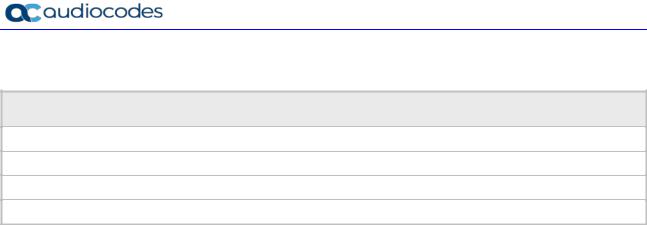
445HD IP Phone
Related Documentation
Document Name
400HD Series IP Phones for Microsoft Skype for Business Release Notes
400HD Series IP Phones for Microsoft Skype for Business Administrator’s Manual
445HD IP Phone for Microsoft Skype for Business Quick Guide
400HD Series IP Phones for Skype for Business Hosting Partner (LHPv2) Environment Configuration Note
User's Manual |
10 |
Document #: LTRT-14842 |

User's Manual |
1. Introducing the 445HD IP Phone |
1 Introducing the 445HD IP Phone
AudioCodes' 445HD IP Phone for Microsoft Skype for Business is based on AudioCodes High Definition voice technology, providing clarity and a rich audio experience in Voice-over-IP (VoIP) calls.
Note: Microsoft rebranded Lync as Skype for Business so whenever the term Skype for Business appears in this document, it applies also to Lync.
The 445HD IP phone is an advanced high-end business phone with a 4.3" color screen. The 445HD includes an integrated, dedicated LCD sidecar displaying contacts and their presence.
The phone is a 1-line, 2 concurrent calls per line, premium model which includes a large, color, multi-language graphic Liquid Crystal Display (LCD).
The phone is a fully-featured telephone that provides voice communication over an IP network, allowing you to place and receive phone calls, put calls on hold, transfer calls, make conference calls, etc.
AudioCodes IP phones can be offered as part of our of Managed IP Phones solution which defines the phone as an IT-managed entity and delivers unique and complete lifecycle management of end-user desktop devices.
Read this User’s Manual carefully to learn how to operate the product and take advantage of its rich feature set.
1.1About AudioCodes' Series of High Definition IP Phones
AudioCodes Series of High Definition IP Phones offers a new dimension of voice call quality and clarity for the IP Telephony market. This new series of IP Phones further expands AudioCodes’ VoIP product offering for the service providers’ hosted services, Enterprise IP telephony and Enterprise contact centers markets. As a natural addition to the AudioCodes Mobile Clients, Media Gateway, Media Server & Multi-Service Business Gateway products, the AudioCodes Series of High Definition IP Phones enable Systems Integrators and end-customers to build end- to-end solutions that rely on AudioCodes’ technological advantage and proven track record in providing state-of-the-art products. The AudioCodes Series of High Definition IP Phones meet a growing demand for High Definition VoIP solutions in end-user phones and terminals, improving the productivity and efficiency of business communications with new quality standards set by the High Definition voice technology.
1.2Cutting Edge Voice Quality & HD VoIP
Based on AudioCodes’ advanced, robust and field-proven VoIPerfectHD™ software, AudioCodes’ IP Phones are designed to utilize wideband coders. The phones feature enhanced proprietary capabilities such as packet loss concealment, high quality wideband acoustic echo canceler, and low-delay adaptive jitter buffers to enrich the HDVoIP experience.
Version 3.1.1 |
11 |
445HD IP Phone |

445HD IP Phone
This page is intentionally left blank.
User's Manual |
12 |
Document #: LTRT-14842 |
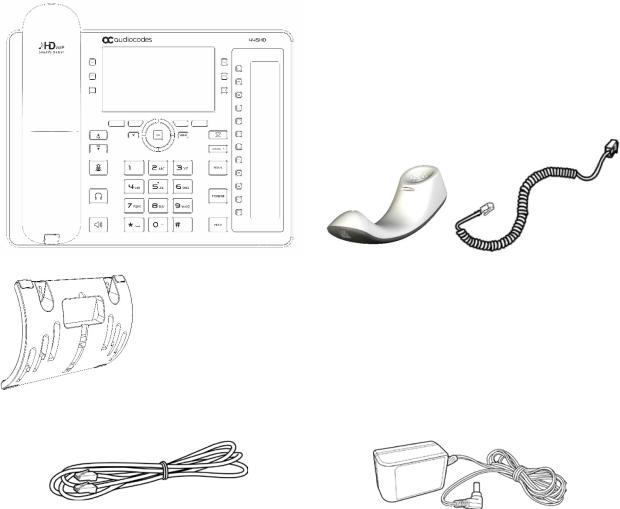
User's Manual |
2. Setting up the Phone |
2 Setting up the Phone
2.1Unpacking
When unpacking, make sure the following items are present and undamaged:
IP Phone / Stand |
Handset / Cord |
Cat 5e Ethernet Cable |
AC Power Adapter (Optional) |
If anything appears to be missing or broken, contact the distributor from whom you purchased the phone for assistance.
2.2Device Description
Use the graphics below to identify and familiarize yourself with the device's hardware functions.
2.2.1Front View
The front view of the phone is shown in Figure 2-1 and described in Table 2-1.
Version 3.1.1 |
13 |
445HD IP Phone |
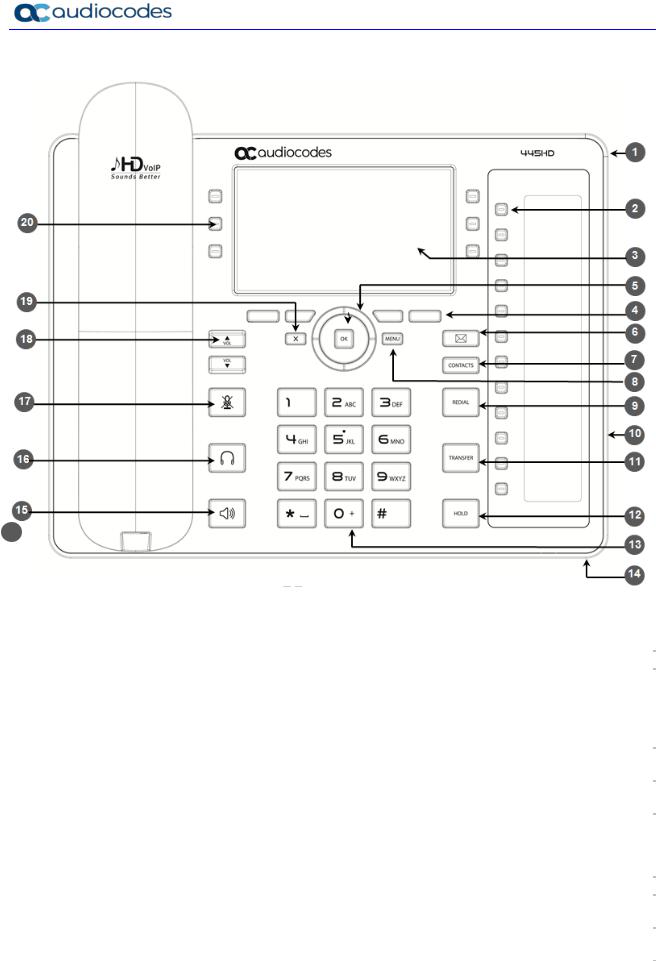
445HD IP Phone
Figure 2-1: Front View
15
|
|
Table 2-1: Font View Description |
|
|
|
Item # |
Label/Name |
Description |
|
|
|
1 |
Ring LED |
Flashing blue light visually indicates an incoming call. |
2 |
Speed Dial & |
Twelve speed dial buttons to quickly call the contact whose name is |
|
BLF |
displayed adjacent to it. You can configure these speed dial buttons with |
|
|
Busy Lamp Field (BLF) functionality. On the 440HD phone, a dedicated |
|
|
electronic screen displays contacts’ names. On the 430HD phone, you can |
|
|
attach to a paper strip handwritten contacts’ names. |
3 |
Screen |
Interactive screen displaying calling information and letting you configure |
|
|
phone features. |
4 |
Softkeys |
See Section 3.2 for details on the four softkeys and the available functions |
|
|
they offer. |
5 |
Navigation |
Press the upper rim to scroll up menus/items in the screen. Press the lower |
|
Control / OK |
rim to scroll down. Press the left or right rim to move the cursor left or right |
|
|
(when editing a contact number for example). Press the OK button to select |
|
|
a menu/item/option. |
6 |
Voicemail |
Retrieves voicemail messages. |
7 |
CONTACTS |
Press to open the 'Favorites' directory. Other directories can be accessed |
|
|
from the 'Favorites' screen. |
8 |
MENU |
Accesses menus: (1) Call Log (2) Calendar (3) Keys Configuration |
|
|
(4) Settings (5) Device Status (6) Administration (7) Favorites (8) Log upload. |
9 |
REDIAL |
Accesses a list of recently dialed numbers; one can be selected to redial. |
User's Manual |
14 |
Document #: LTRT-14842 |

|
User's Manual |
2. Setting up the Phone |
||||
|
|
|
|
|
|
|
|
|
Item # |
Label/Name |
Description |
|
|
|
|
|
|
|
|
|
|
10 |
Kensington lock |
Allows locking the device. |
|
||
|
11 |
TRANSFER |
Transfers a call. |
|
||
|
12 |
HOLD |
Places an active call on hold. |
|
||
13Alphanumerical Keys for entering numbers, alphabetical letters and symbols (e.g., colons)
Keypad
14 |
Microphone |
Allows talking and listening. Network administrators can disable it if required. |
|
15 |
SPEAKER |
Activates the phone's speaker, allowing a hands-free conversation. |
|
16 |
HEADSET |
Activates a call using an external headset. |
|
17 |
MUTE |
Mutes a call. |
|
18 |
▲ VOL |
Increases or decreases the volume of the handset, headset, speaker, ring |
|
▼ VOL |
tone and call progress tones. |
||
19 |
x |
Cancel an action, such as dialing a number, after beginning it. |
|
20 |
--- |
Programmable keys, located on each side of the screen, to which you can |
|
assign functions. |
|||
|
|
2.2.2Rear View
The rear view of the phone is shown in the figure below and described in the table below.
Figure 2-2: Rear View
|
|
Table 2-2: Rear View Description |
|
|
|
# |
Label |
Description |
|
|
|
1 |
|
Handset jack, i.e., RJ-9 port, to connect the handset. |
|
|
|
2 |
|
RJ-45 port to connect to the Ethernet LAN cable for the LAN connection |
|
|
(uplink - 10/100/1000 Mbps). If you're using Power over Ethernet (PoE), |
|
|
power to the phone is supplied from the Ethernet cable (draws power |
|
|
from either a spare line or signal line). |
3 |
|
RJ-45 port to connect the phone to a PC (10/100/1000 Mbps downlink). |
|
|
|
4 |
|
12V DC power jack that connects to the AC power adapter. |
|
|
|
5 |
|
Headset jack, i.e., RJ-9 port that connects to an external headset. |
|
|
|
Version 3.1.1 |
15 |
445HD IP Phone |
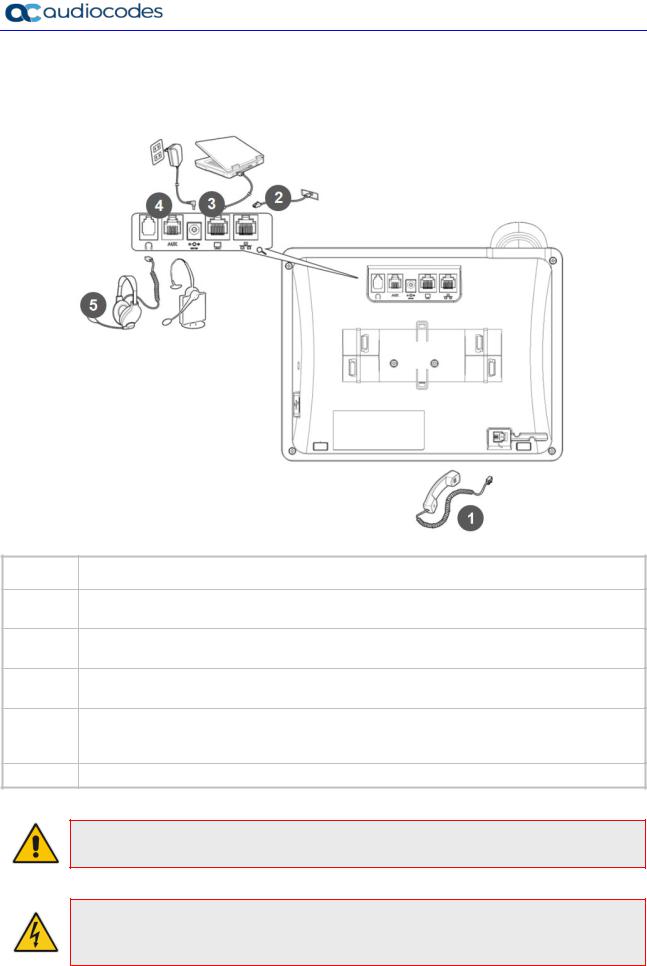
445HD IP Phone
2.3Cabling
Here's how to cable your phone.
Figure 2-3: Cabling
Action |
Description |
|
|
1Connect the short, straight end of the cord to the handset.
Connect the longer, straight end to the jack (RJ-9 port, for the handset) on the phone.
2Connect the RJ-45 LAN port to your LAN network (LAN port or LAN switch/router), using a CAT 5 / 5e Ethernet cable
3Connect the RJ-45 PC port to a computer, using a CAT 5 / 5e straight-through Ethernet cable
4Connect the connector tip of the AC power adapter to the phone’s power socket (labelled DC 12V). Connect the two-prong AC adapter directly to the electrical wall outlet. When the phone powers up, all the LEDs momentarily light up
5Connect the RJ-9 headset jack to a headset (optional)
Note: If the LAN to which the phone is connected supports Power over Ethernet (PoE), no AC adapter is required; the phone receives power from the Ethernet network.
Prior to connecting power, refer to the Compliancy and Regulatory Information at www.audiocodes.com/library.
User's Manual |
16 |
Document #: LTRT-14842 |
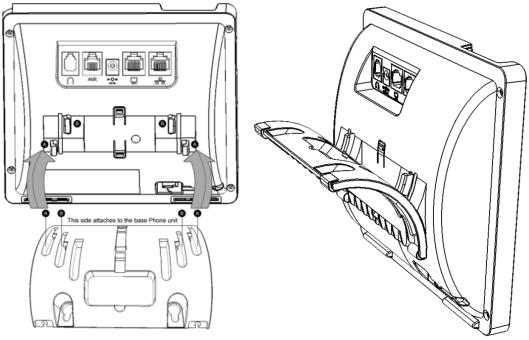
User's Manual |
2. Setting up the Phone |
2.4Mounting the Phone
The phone can be mounted on a:
Desk (see Section 2.4.1 below)
Wall (see Section 2.4.2)
See also https://www.youtube.com/watch?v=oGe9STB9lFE to assemble the base stand.
2.4.1Desktop Mounting
Here's how to place the phone on a desk or flat surface.
To mount the phone on a desk or flat surface:
1.Off-hook the handset (if on-hook) and place the phone upside down, i.e., base-up, on your desktop.
2.On the phone's base, identify outer rails.
3.On the phone's stand, identify outer notches.
4.Invert the stand and align its outer notches with the base's outer rails.
5.Insert the stand's outer notches into the base's outer rails and slide the notches along the rails until the stand click-locks into the base.
6.Revert the phone and stand it on the desktop.
2.4.1.1Routing the Handset Cable
The phone features a groove for routing the handset cable.
2.4.2Wall Mounting
Here's how to mount the phone on a wall.
To mount the phone on a wall:
1.Attach the stand of the phone for the purpose of a wall mounting: a. Detach the base.
Version 3.1.1 |
17 |
445HD IP Phone |
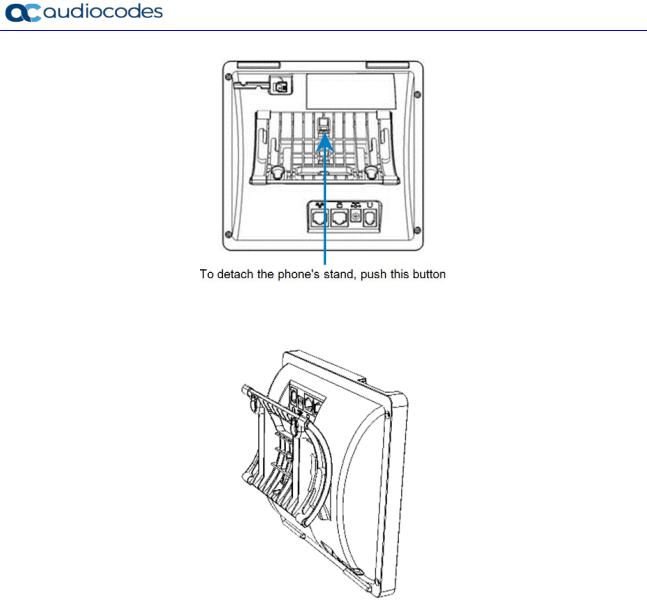
445HD IP Phone
b.Attach it again as you did for a desktop mounting (see Section 2.4.1) only now make sure that it's flatly aligned to lie flush against the wall, i.e., slide the inner rails of the phone stand onto the phone base's inner notches.
2.Connect the AC power adapter, LAN and PC cords.
3.In the wall, drill two horizontal holes at a distance of 3 15/16 inches (100 mm) from one another, in line with the template.
4.Insert two masonry anchors into the holes if necessary.
5.Thread two screws (not supplied) into the two masonary anchors; ensure that the heads extend sufficiently (about 3/16 inch or 5 mm from the wall) for the phone stand's keyhole slots to hang on.
6.Hang the phone stand's keyhole slots on these screws.
User's Manual |
18 |
Document #: LTRT-14842 |

User's Manual |
3. Getting Started |
3 Getting Started
Now you can get started with your phone. The phone's screen provides you with an intuitive, menu-driven user interface for configuring the device and viewing call information.
3.1Getting Acquainted with the Phone Screen
The figure below shows the phone’s screen in idle state.
Figure 3-1: Phone Screen in Idle State
|
|
Table 3-1: Phone Screen in Idle State |
|
|
|
|
|
|
Reference |
Description |
|
|
|
|
|
|
|
Presence status (Available, Busy, Do not disturb, Be right back, Off Work and Appear |
|
|
1 |
Away). See Section 6.20 for details. |
|
|
User name and phone number configured by your network administrator using the Web |
|
|
|
|
|
|
|
|
interface. |
|
|
|
|
|
|
|
Day, Date and Month, automatically retrieved from the Network Time Protocol (NTP) |
|
|
2 |
server, enabled by your network administrator. |
|
|
Time, automatically retrieved from the Network Time Protocol (NTP) server, enabled by |
|
|
|
|
|
|
|
|
your network administrator. |
|
3Softkeys; to activate a softkey, press the hard key on the device, located below the screen, corresponding to the softkey. See Table 3-2 for softkey descriptions.
Version 3.1.1 |
19 |
445HD IP Phone |

445HD IP Phone
3.2Softkeys
Here are descriptions of the softkeys that are displayed in the phone screen.
|
Table 3-2: Softkeys |
|
|
Softkey |
Description |
|
|
Meet Now |
Initiates a phone conference based on the Skype for Business server. |
|
|
Missed |
Displays missed calls. |
|
|
Forward |
Automatically forwards calls. |
|
|
Status |
Displayed in idle state. Lets you sets your presence status: Available, Busy, Be right back, Off |
|
Work, Appear Away. |
|
|
Sign in |
Sign in is displayed if you haven't signed in yet. |
/Sign out |
Sign out is displayed if you press the Status softkey after signing in. |
Directory |
Displayed after lifting the handset (for example). Opens the 'Favorites' defined in the Skype |
|
for Business client. |
Call Log |
Displayed after lifting the handset (for example). |
|
|
Select |
Identical to the hard OK key on the phone. Either can be used. Selects a menu or option. |
|
|
BToE |
Displayed after pressing the MENU hard key unless disabled by the network administrator. |
|
Generates a code for manually pairing the phone with Skype for Business client for unified |
|
communications. |
A/a/1 |
Enables switching between input modes: abc, ABC, Abc, 123, or T9. |
|
|
Save |
Saves settings. |
|
|
Cancel |
Cancels the currently initiated call or configuration. |
|
|
Dial |
Displayed after a number is keyed, a directory contact is selected, or a logged call is |
|
selected. |
Clear |
Displayed after entering a digit of a phone number (for example). Deletes from right to left. |
|
|
Call Menu |
Displayed after dialing a number and it's answered, and after you answer a call. |
|
|
Conf |
Displayed (1) after a number is dialed and the call is answered on the other side and (2) after |
|
you answer a call. Pressing it displays the ADD PARTICIPANT screen. |
BXfer |
Displayed (1) after a number is dialed and the call is answered on the other side and (2) after |
|
a call is answered. Lets you transfer the call in a blind transfer. |
URL |
Displayed after lifting the handset (for example). Enables calling a URL. |
|
|
Detail |
Displayed after selecting a call log (for example). If selected, the details of a logged call are |
|
displayed (Time, Date, etc.). |
Favorite |
Displayed in the Call Details screen. Allows adding the person to the Favorites directory. |
|
|
End |
Displayed after pressing the Dial softkey (for example). Ends the call. |
|
|
Back |
Displayed after pressing the MENU key (for example). Returns to the previous screen. |
|
|
Edit |
Displayed after you select a contact to be edited (for example). |
|
|
Delete |
Displayed after pressing the MENU key and then selecting Call Log (for example). |
|
|
Silent |
Displayed when the phone rings on an incoming call. Lets you silence the ring. |
|
|
Reject |
Displayed when the phone rings, alerting to an incoming call. Lets you reject the call. |
|
|
Accept |
Displayed when the phone rings, alerting to an incoming call. Lets you accept the call. |
|
|
User's Manual |
20 |
Document #: LTRT-14842 |
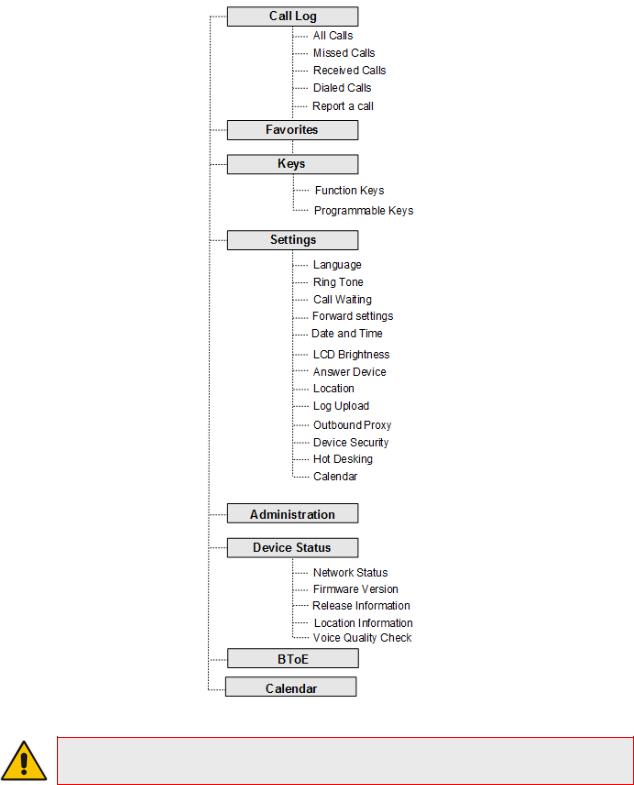
User's Manual |
3. Getting Started |
3.3Navigating the Phone Menu
The MENU key on the phone lets you access information and configure settings shown in the figure below. Press it to view call logs, view meetings scheduled in the calendar for that day (integrated with Skype for Business client), configure speed dials, customize phone settings, determine device status, perform administration, access 'Favorites' and other phone directories, and perform log upload to Microsoft server.
Figure 3-2: Phone Menu
Note: The Administration option is intended for network administrators only. It is password protected. See the Administrator’s Manual for details.
Version 3.1.1 |
21 |
445HD IP Phone |
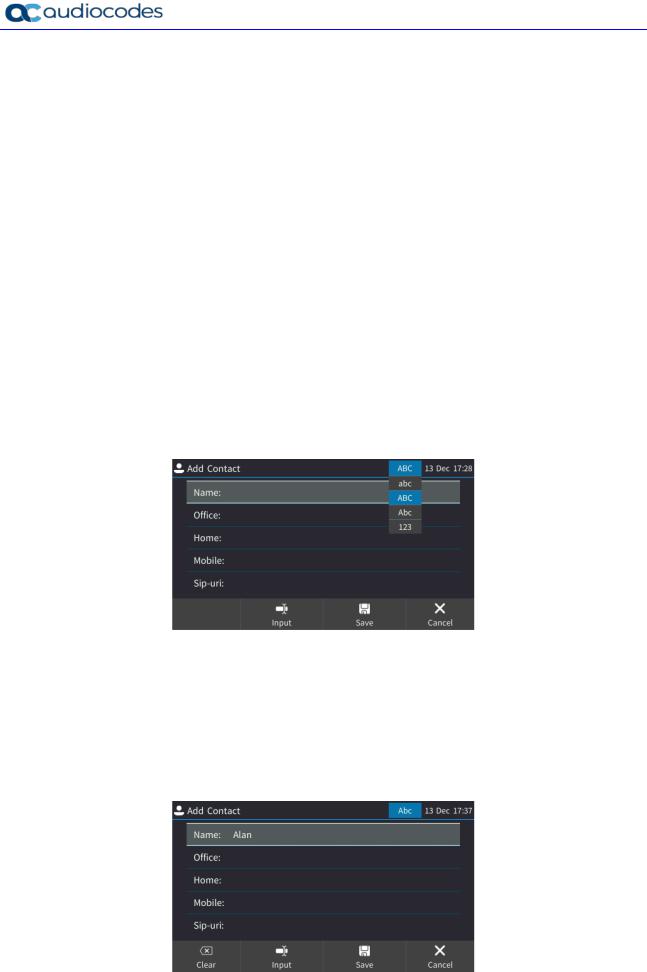
445HD IP Phone
To access the menus:
Press the MENU key located on the device.
|
To navigate to menu items: |
|
After opening the menu, press the navigation control button's lower rim -OR- press the menu |
|
item's number, e.g., press 3 to navigate to Keys Configuration. |
|
To select a menu or menu item: |
Press the Select softkey or press the navigation control's OK button.
To cancel and move to a previous menu level:
Press the Back softkey.
3.4Switching between Letters | Numbers
The keypad allows you to enter upper case letters, lower case letters and numbers, and to switch from one mode to another.
To enter a contact's name (for example):
1.In the Add Contact screen, press the the # key on the keypad.
Figure 3-3: Switching between Letters | Numbers
2.Press the # key successively to navigate to and select the mode:
•abc = lower case letters
•ABC = upper case letters
•Abc = first letter upper case, the rest lower case
•123 = numbers
3.[For example] Select Abc mode and then on the keypad, press the 2 key; A is entered. Press the 5 key three successive times; l is entered (once produces j, twice produces K). Similarly, enter a and n.
User's Manual |
22 |
Document #: LTRT-14842 |
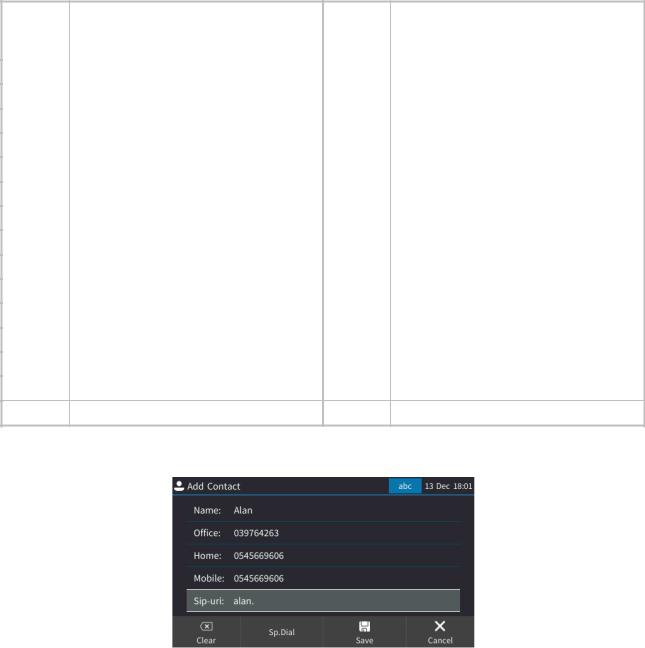
User's Manual |
3. Getting Started |
3.5Switching to Symbols
The keypad allows you to switch to symbols and to revert from symbols mode to letters or numbers mode.
To enter a symbol (e.g., dot or @ or hyphen):
1.Press the # key successively to navigate to and select abc (mandatory).
2.Press the 1 key on the keypad; a period / full stop is entered. Immediately press the 1 key again; a backslash is entered. Pressing successively produces the following symbols:
|
Symbol |
Explanation |
|
Symbol |
Explanation |
|
|
|
|
|
|
|
|
|
. |
Dot |
* |
Star sign |
|
|
|
|
|
|
|
|
|
|
\ |
Backslash |
= |
Equal sign |
|
|
|
|
|
|
|
|
|
|
@ |
At |
| |
Separator |
|
|
|
|
|
|
|
|
|
|
; |
Semi-colon |
( |
Open parenthesis |
|
|
|
|
|
|
|
|
|
|
: |
Colon |
) |
Close parenthesis |
|
|
|
|
|
|
|
|
|
|
# |
Pound |
{ |
Open parenthesis |
|
|
|
|
|
|
|
|
|
|
$ |
Dollar |
} |
Close parenthesis |
|
|
|
|
|
|
|
|
|
|
% |
Percentage |
[ |
Open square parenthesis |
|
|
|
|
|
|
|
|
|
|
^ |
Caret |
] |
Close square parenthesis |
|
|
|
|
|
|
|
|
|
|
& |
Ampersand |
" |
Double quotation marks |
|
|
|
|
|
|
|
|
|
|
! |
Exclamation mark |
' |
Single quotation mark |
|
|
|
|
|
|
|
|
|
|
? |
Question mark |
> |
Greater than |
|
|
|
|
|
|
|
|
|
|
+ |
Plus |
< |
Less than |
|
|
|
|
|
|
|
|
|
|
- |
Hyphen |
, |
Comma |
|
|
|
|
|
|
|
|
|
|
_ |
Underscore |
/ |
Forward slash |
|
|
~Approximates
Note that the asterisk (*) symbol is entered directly using the star key.
Figure 3-4: Entering a Symbol, e.g., a dot
Version 3.1.1 |
23 |
445HD IP Phone |
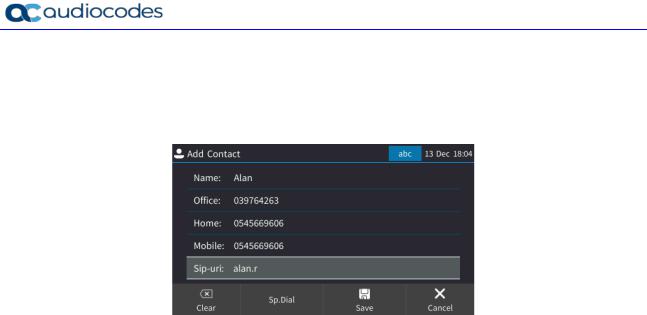
445HD IP Phone
To revert to letters, e.g., abc:
Make sure you're in abc mode and successively press the 7 key three times to produce (for example) r:
Figure 3-5: Reverting to Letters, e.g., abc
User's Manual |
24 |
Document #: LTRT-14842 |

User's Manual |
4. Signing In |
4 Signing In
Before you can use your phone, you need to sign in. Sign in options are:
PIN code – go here
User name and password – go here
Web Cloud (Office 365) - go here
Web Login - go here
CAP Provisioning – go here
Note:
•Your network administrator will advise you which option to use and will provide you with the necessary sign-in information.
•Sign-in can be cancelled during the signing in procedure. You can cancel signing in after starting the sign-in process.
4.1Signing in with PIN Code
The Postal Index Number (PIN) is a post office numbering code used to secure sign-in. Your network administrator will provide you with your PIN code.
To sign in using this option:
1.In the Offline screen press the Sign in softkey, and then select the PIN Code option.
2.Enter your phone number and then navigate down to enter your PIN code. You can get it from your network administrator. To switch between numbers and letters and symbols, see Section 3.4 and 3.5.
3.Press the Sign in softkey; the Lock Code screen opens (see Section 5 for more information).
4.Enter a lock code, confirm it, and then press Save. The idle screen is displayed.
Version 3.1.1 |
25 |
445HD IP Phone |
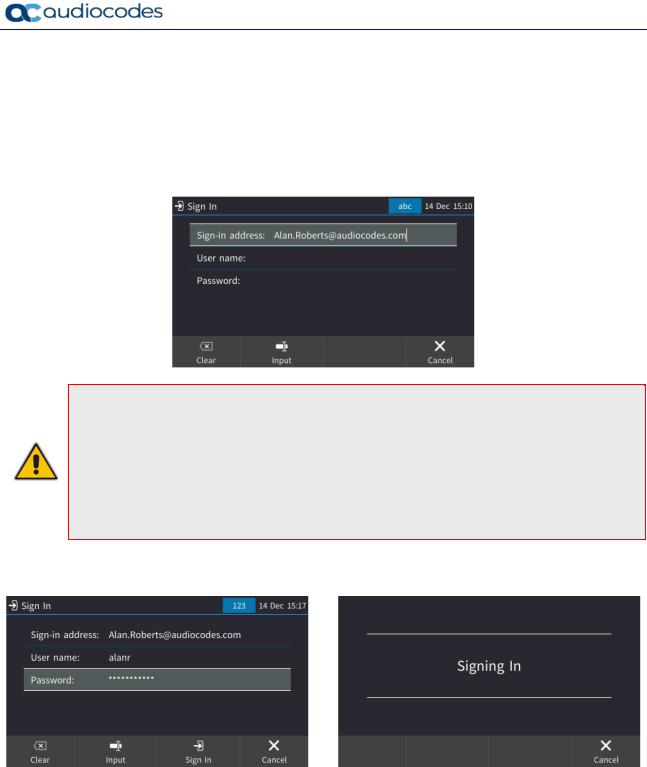
445HD IP Phone
4.2Signing in with User Name and Password
This online sign-in option enables connectivity to Microsoft Office 365 and to Microsoft's Cloud PBX, Microsoft's cloud-hosted version of enterprise voice.
To sign in with user name and password:
1.In the 'Sign-in options' screen, select User name and Password.
Note: Signing in with a username that is a NetBIOS Domain Name, i.e., domain\username, or with the PIN Code, are disallowed for Skype for Business online sign-in. They are only allowed for on-premises sign-in. Online sign-in must be in the following format:
•Sign-in address, i.e., SIP URI. To switch between letters and symbols such as @, - and period, see Section 3.5.
•User name, in UPN (User Principal Name) format, i.e., the way the user's name appears in their e-mail address listed in the Active Directory: username@domain.com
•User’s network IT password (the same password you use to access your PC)
2.Press the Sign in softkey that's displayed; after signing in successfully, the New Device Lock Code screen opens (see under Section 5 for more information).
User's Manual |
26 |
Document #: LTRT-14842 |
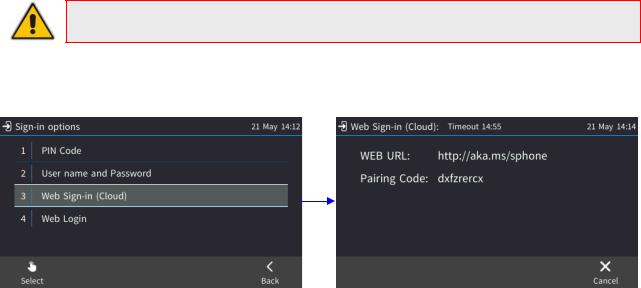
User's Manual |
4. Signing In |
4.3Signing in with the Web Sign-in (Cloud) Option
Signing in with the Web Sign-in (Cloud) sign-in option enables connectivity to Microsoft's Cloud PBX, Microsoft's cloud-hosted version of enterprise voice. The sign-in option, a.k.a. Device Pairing, exempts users from having to laboriously key in their user name and password using the phone keypad.
Note: Applies only to Microsoft Cloud PBX users.
To sign in with this option:
1.In the 'Sign-in options' screen, select Web Sign-in (Cloud).
2.Point your browser to the displayed URL and sign in to Office 365.
Version 3.1.1 |
27 |
445HD IP Phone |
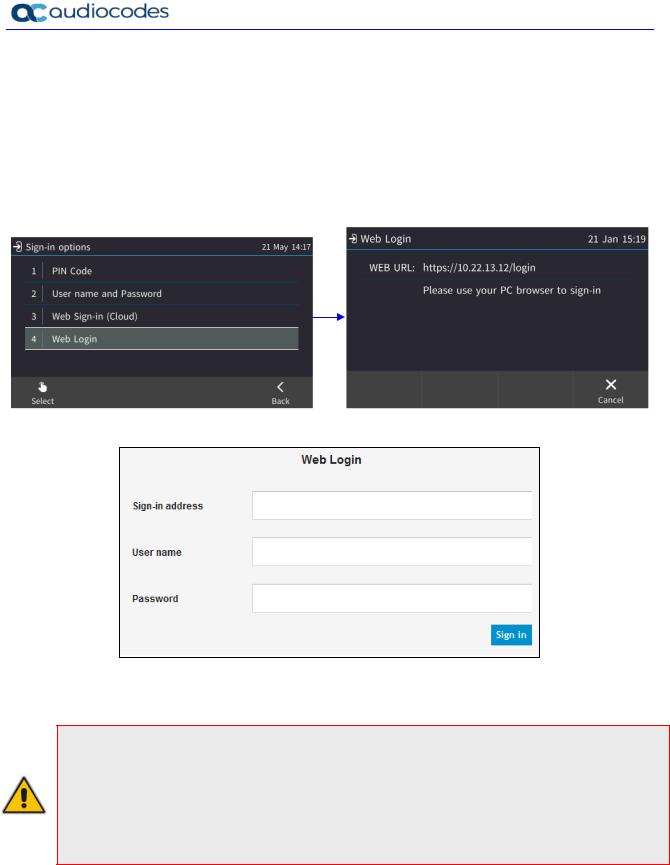
445HD IP Phone
4.4Signing in using the Web Login Option
Users can sign-in to their phone from their browser using their PC keyboard to quickly enter signin credentials rather than use the longer method on the phone's keypad which requires switching input from letters of the alphabet to numbers and vice versa. [Applies to Skype for Business online and on-premises].
To sign in using the Web Login option:
1.When the phone is offline, press the Sign-in softkey and select Web Login.
2.Enter the displayed Web URL in your browser's address field <phone IP address>/login
3.Enter your username and password (ask the network administrator if necessary) and then click Sign in.
Note:
•If CAP is enabled (see the next section), the sign-in option CAP Provisioning replaces the signin option Web Sign-in (Cloud).
•If the BToE PC application is automatically paired with the phone (when the phone's PC port is directly connected to the PC), the sign-in option BToE replaces the sign-in option Web Login.
•If the BToE PC application is manually paired with the phone, the Web Login sign-in option is presented rather than the BToE option.
User's Manual |
28 |
Document #: LTRT-14842 |
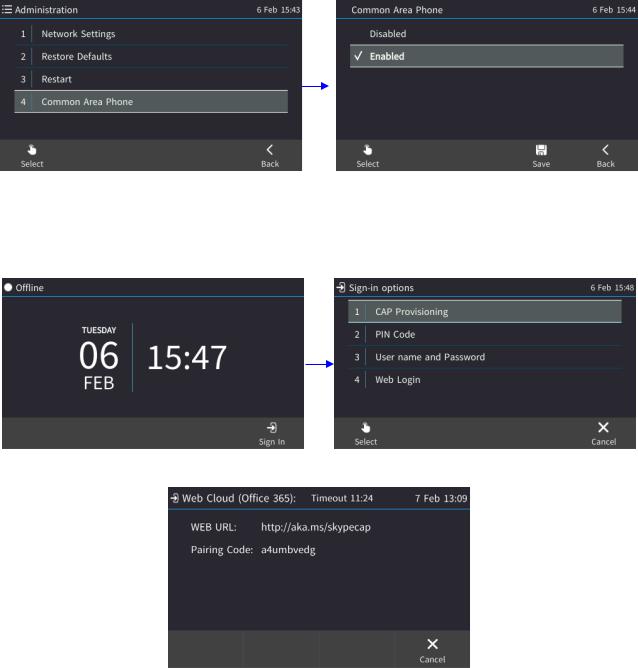
User's Manual |
4. Signing In |
4.5Signing in as a Common Area Phone (CAP) User
Phones can be defined as CAPs. Defined per physical phone rather than per user, a CAP requires a special sign-in method called 'CAP Provisioning'. Before signing in using the 'CAP Provisioning' option, the network administrator must enable the phone as a CAP.
To enable the phone as a CAP on the phone:
After the phone is enabled as a CAP, it restarts.
To sign in using the CAP Provisioning option:
1.When the phone is offline, press the Sign-in softkey and from the 'Sign-in options' screen select CAP Provisioning.
2.After selecting the 'CAP provisioning' method, view a displayed URL and Pairing Code.
3.Point your browser to the URL, sign in to Office 365 and locate the phone.
Version 3.1.1 |
29 |
445HD IP Phone |

445HD IP Phone
User's Manual |
30 |
Document #: LTRT-14842 |
